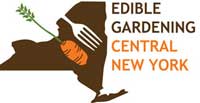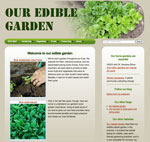Robbing the life savings of garden beds
by Sara Stein
|
 | "Limp bodies of weeds"
(See more at |
|
But I realize now that to help one's garden overmuch is to hinder it. I must have been living in another world when I wrote, only a few years ago and with considerable satisfaction, of the view from my window of our gardens "bare to their bones, neat and clean, nicely edged, weed-free."
Now I see that there is teeming life down there that, neatly and cleanly, I was starving.
Why was I not replacing in their beds the limp bodies of weeds I had uprooted? What was I doing cutting flowers to the ground, raking them away, bagging grass clippings, blowing autumn leaves from underneath the hedge?
I was robbing the life savings from my garden beds, exposing them to the elements to leach their lifeblood away.
~ Sara Stein, Noah's Garden: Restoring the Ecology of Our Own Back Yards, 1993, pp. 134-135
|
Learn by doing! Help maintain the zoo garden
|
 | | The zoo's habitat garden |
|
One of the best ways to learn anything is work alongside experts and other learners like yourself. A great way to learn more about habitat gardening and native plants is to volunteer to help maintain the habitat garden at the zoo. Contact Kate Woodle if you're interested. The "crew" meets Sundays. |
| Our Habitat Garden |  |
Visit Our Habitat Garden website for information on providing habitat, earth-friendly gardening practices, plants, and various creatures here in Central New York.
|
|
Join HGCNY!
|  |
Becoming an official member of HGCNY is easy: just join Wild Ones! When you're a Wild Ones member, you're automatically an official member of HGCNY. |
| HGCNY on Facebook |
As as more of us participate on our Facebook page, this will become a useful resource for asking (and answering!) local HGCNYers' questions about habitat gardening. |
| Interested in Edible Gardening? | 
|
If you'd like to get information on Edible Gardening CNY, just email John to find out about edible gardening tours and monthly programs. Free and open to the public! |
|
Our Edible Garden: updated with GROUNDHOG info!
|  | Visit OurEdibleGarden.org to see an example of a Central New York edible garden, the perfect companion to your habitat garden.
Here's our experiences with groundhogs, and here's our solution to the groundhog problem!
|
|
Greetings!
 | | Tour a habitat garden |
Show Me, Help Me Tours
Summer is time to explore our fellow HGCNYers' gardens. We have a number of tours scheduled. They're all free and open to the public.
** JULY **
Wed., July 25 at 6:00 pm: After many years abroad, Bill Wallauer, a filmmaker and conservationist with the Jane Goodall Institute, has chosen Syracuse as his home base. For the last few years, the Wallauers have been transforming a typical American yard into an urban wildlife habitat and edible garden. Their 50'x150' yard includes a woodland area with spring ephemerals, a wetland area with a pond and stream, and lots of native plants. They've already seen an increasing number of birds and other creatures visiting their habitat. Address: 253 Kensington Place in the Syracuse University area. Please confirm date and time with Bill. Sat. July 28 at 10:00 am: We'll tour the zoo's habitat garden with Kate Woodle as our guide. This is a large garden area outside the entrance to the zoo, and many of our HGCNY members are helping maintain it. Since it is outside the gate, zoo admission is not required. ( Directions) ** AUGUST **
Sun. Aug. 5 at 8:30 am: We'll tour Chris's garden (I81 Cicero exit, just off Route 11). It's about a third of an acre, and she's in the process of planting it as an edible and a habitat garden. She's willing to dig herbs for people that morning! She has made a lot of progress, but could use help with native ID and would welcome ideas about what to plant. Please RSVP to Chris for directions; limited to 15 people, but there's still space available! Sun. Aug. 19 at 2:00 pm: We'll tour Linda Rossiter's wooded property in a residential area in Fulton. It's just under a half-acre and borders a Class II wetland with stream. The gardens--including some deep shade and part-shade gardens--are being transitioned towards all native plants. Bring binoculars to view the marsh, and bring boots if you'd like to go into the marsh. Joe-pye weed, boneset, goldenrod should all be in full bloom! Linda would like help with plant ID and suggestions for new plants to add. RSVP to Linda for directions.
~ Janet Allen
|
|
 GUESS what this chickadee is doing! (The answer is at the bottom of this newsletter.) |
|
Share a photo of your Monarch Waystation
 | | Monarch Waystation sign |
If you have milkweeds, nectar plants, and refrain from using pesticides, you're helping monarch butterflies survive, and you may even have an official Monarch Waystation.
If you've met the Monarch Watch requirements for providing for the monarch's needs, you can become certified and are eligible to purchase a sign. (Note: Monarch Watch includes non-natives on their plant list, but we suggest natives instead!)
If you have a certified Waystation, send a digital photo, and we'll create a page on our HGCNY website showing the Monarch Waystations in CNY.
Please include your Waystation number and how you would like to be identified (e.g. "Syracuse," "Sam from Syracuse," "Sam Smith at 100 Main St., Syracuse," etc.--whatever level of specificity you're comfortable with).
You're also welcome to include a brief paragraph indicating what kind of milkweed and other native nectar plants are in your Waystation and any other information of interest. |
|
Featured creature: Toads
 | | A young American toad |
One of the most valuable creatures in your yard (if you're lucky enough to have them) is the American toad (Bufo americanus).
They're nicknamed "bats of the ground" since they eat so many insects, earwigs, cutworms, grubs and beetles. In fact, a toad eats two or three times its weight a day and up to 10,000 pests a season!
Toads generally spend their day hiding under logs, rocks or leaf litter, then they come out at night to hunt. Unfortunately, since they find a lot of insects in open areas near roads, they're often hit by cars. Besides cars, they're also especially vulnerable to pesticides because of their permeable skin. They hibernate in the winter, burrowing up to three feet under the ground. Amazing fact: They can live up to 30 years! A common myth: No, they do NOT give you warts, though their skin can contain secretions irritating to mucus membranes (ask your dog). But if you handle them, they may excrete a lot of urine (not harmful, but ...) At any rate, wash your hands after handling a toad, and don't touch your mouth or eyes until you do. To create a toad-friendly yard, provide some hiding spots in moist areas, food (not a problem in most gardens!), and a semi-permanent water source for spring breeding. And, of course, limit your use of pesticides since they not only directly harm the toads, but they also kill their prey. Read more about toads in Our Habitat Garden. |
|
Our Native Plant Shopping Guide tells you where to find native plants
 | |
(Click image to download)
|
To help you find native plants in CNY, we've compiled a list of plants offered by several local nurseries. REMEMBER, nurseries can sell out of any particular plant, so it's a good idea to call before setting out on your shopping trip! DOWNLOAD: This guide is available online as a free .pdf download. |
|
ANSWER: What the chickadee was doing
 | | He got the worm! |
The chickadees have been hard at work feeding their babies, who have an insatiable appetite and are very insistent about being fed. These overworked parents look quite ragged by this time of the year.
 | | The small white worm in the middle of the flower |
I noticed both parents landing on the monardas, then going over to the babies. I checked out the monardas, and sure enough, they were finding little white worms hidden inside the top of the monarda flowers! They spent quite a bit of time in the monarda patch, and the babies got a good meal. |
|
|
|
|